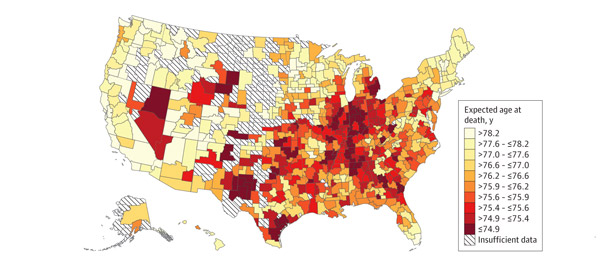The Association Between Income and Life Expectancy in the United States, 2001-2014
In a groundbreaking analysis of US income and mortality data since 2001, researchers report that:
- Life expectancy at age 40 increases continuously with income percentile.
- The wealthiest 1% have a life expectancy at age 40 that’s 10-15 years greater than the poorest 1%.
- The rise in life expectancy associated with income becomes much smaller above a household income of about $200,000.
- Expected age at death for 40-year-olds increased for people in the top income quartile at a rate about 2.5 times that for people in the bottom income quartile.
- Life expectancy at age 40 differs by location, favoring New York and California for people in the bottom income quartile and Utah and Maine for those in the top income quartile.
- Most of the difference in life expectancy between the wealthiest and poorest seems attributable to health behaviors.
Related Articles
Related Multimedia
JAMA Summary Video: The Association Between Income and Life Expectancy in the United States, 2001-2014
More From the JAMA Network
Equity in Cancer Care and Outcomes of Treatment: A Different Type of Cancer Moonshot
JAMA | Viewpoint, March 22/29, 2016
Disparities in Time Spent Seeking Medical Care in the United States
JAMA Internal Medicine | Research Letter, December 2015
Disparities in the Use of Breast-Conserving Therapy Among Patients With Early-Stage Breast Cancer
JAMA Surgery | Original Investigation, August 2015
Changes in Socioeconomic, Racial/Ethnic, and Sex Disparities in Childhood Obesity at School Entry in the United States
JAMA Pediatriacs | Research Letter, July 2015
Racial/Ethnic Disparities Associated With Initial Hemodialysis Access
JAMA Surgery | Original Investigation, June 2015
Association Between Competitive Food and Beverage Policies in Elementary Schools and Childhood Overweight/Obesity Trends: Differences by Neighborhood Socioeconomic Resources
JAMA Pediatriacs | Original Investigation, May 4, 2015
Race, Poverty, and Medicine in the United States
JAMA | Editorial, April 14, 2015
Achieving Health Equity by Design
JAMA | Viewpoint, April 14, 2015
Minority Physicians' Role in the Care of Underserved Patients: Diversifying the Physician Workforce May Be Key in Addressing Health Disparities
JAMA Internal Medicine | Research Letter, February 2014
CDC Report: US Health Disparities Persist
News@JAMA | November 22, 2013
The US Health Disadvantage Relative to Other High-Income Countries: Findings From a National Research Council/Institute of Medicine Report
JAMA | Viewpoint, February 27, 2013
Navigating the Storm That Is Contributing to Health Disparities
JAMA Ophthalmology | Editorial, December 2012
Association of Socioeconomic Position With Health Behaviors and Mortality
JAMA | Original Contribution, March 24, 2010
Impact of Health Disparities Collaboratives on Racial/Ethnic and Insurance Disparities in US Community Health Centers
JAMA Internal Medicine | Original Investigation, February 8, 2010
Relative Child Poverty, Income Inequality, Wealth, and Health
JAMA | Commentary, January 28, 2009
Future Health Consequences of the Current Decline in US Household Income
JAMA | Commentary, October 24/31, 2007
Inequality in Quality: Addressing Socioeconomic, Racial, and Ethnic Disparities in Health Care
JAMA | Policy Perspectives, May 17, 2000
Socioeconomic Factors, Health Behaviors, and Mortality: Results From a Nationally Representative Prospective Study of US Adults
JAMA | Original Contribution, June 3, 1998






 Just Now
Just Now